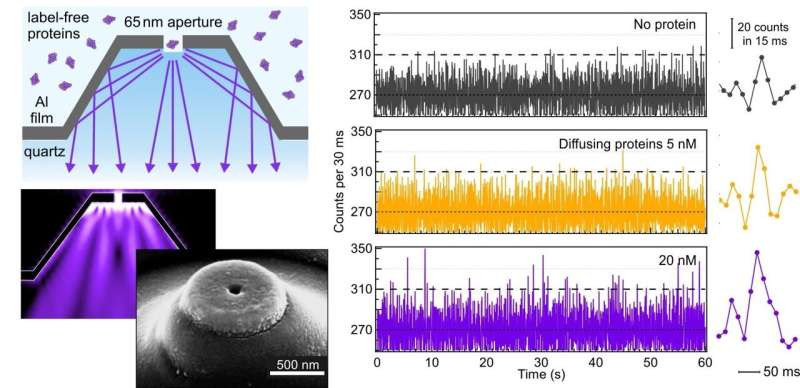Optical horn antenna for single label-free protein detection in the ultraviolet. Credit: © CNRS Institut Fresnel
One of the ultimate goals of molecular biology is to watch how single proteins work in their native state. However, the current mainstream approach of single-molecule fluorescence relies on introducing external fluorescent markers which can lead to severe issues affecting the experimental results. As an alternative to fluorescence labeling, working in the ultraviolet is appealing to take advantage of the intrinsic autofluorescence naturally present in the vast majority of proteins. However, proteins are orders of magnitude dimmer as compared to conventional fluorescent dyes, so single protein UV detection has remained a challenge so far. Hence, new nanotechnology tools need to be introduced.
In a recent publication in Nature Communications, researchers from Institut Fresnel introduce a novel optical horn antenna platform for label-free detection of single proteins in the UV with unprecedented resolutions and sensitivity. The approach combines (i) a conical horn reflector for fluorescence collection at ultrahigh angles with (ii) a metal nanoaperture for fluorescence enhancement and background screening. To experimentally demonstrate the usefulness of the approach and its direct application to biochemical challenges, the real-time detection of UV autofluorescence from immobilized and diffusing single proteins is demonstrated, together with experiments monitoring unfolding and dissociation upon denaturation of a widely used protein with single-molecule resolution. Importantly for biochemical applications, all the single-molecule experiments are performed on label-free proteins and at physiological conditions, which is unique in this scientific field.
Optical horn antennas open up a unique new form of spectroscopy enabling the investigation of single proteins in their native state and in real time. This work provides a leap towards the design of biochemical assays with label-free single protein resolution as well as bright optical nanosources.
More information: Aleksandr Barulin et al, Ultraviolet optical horn antennas for label-free detection of single proteins, Nature Communications (2022). DOI: 10.1038/s41467-022-29546-4
Journal information: Nature Communications
Provided by Aix-Marseille University























